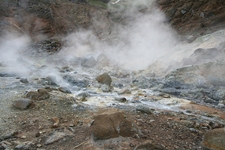As my son would say, with gusto, it works with boiling hot lava!
How does geothermal energy work for heating and cooling? For heating, geothermal energy works by extracting heat from the ground, and pumping it into your living space. For cooling, geothermal energy works by extracting heat from your living space, and pumping it into the ground.
Think of it as a giant fridge, that sometimes runs in reverse (when it’s heating) and sometimes runs like a normal fridge (when it’s cooling). Only instead of running those unsightly coils down the back of the fridge, it runs them underground. More on this below.
How does geothermal energy work for electrical generation? I don’t cover this in detail, because it’s extremely unlikely that homeowners will be able to generate electricity from geothermal energy anytime soon. Geothermal generation is a bit larger scale operation! But here it is in a nutshell.
Basically, geothermal generation takes advantage of hot temperatures below ground, in areas where volcanic activity is high because the earth’s crust is relatively thin. Water is injected below ground; if the ground is made of a permeable rock such as sandstone, the water may already be naturally present. The water comes into contact with hot rock heated by the earth’s magma, and boils into superheated dry steam.
This steam is pushed by its natural expansion (from liquid to gas) up through the earth and into pipes, and captured to power a steam turbine, which produces electricity. The dry steam is then partially released into the atmosphere, and partially condensed and pumped back underground, along with other gases released during the process.
This video does a great job of explaining geothermal electrical generation in under two minutes:
Geothermal heating and cooling
How does geothermal energy work to heat and cool homes? Don’t worry, you won’t have to have exploding magma in your back yard when you install a geothermal heating and cooling system!
The earth has a much more constant temperature than the air. It might be 100F (39C) in summer and -40F (-40C) in winter where you live. But a few feet down the earth will always be a steady temperature, for example 60F or 15C in parts of the US. And even if it’s 100F year-round where you live, a few hundred feet below ground it could still be a pleasant 60-80F.
For every 100 feet you go down into the earth, the temperature rises 1.5F. So if you were to dig down to a depth of 600 feet, assuming the temperature a few feet below ground is 60F, the deeper rock woudl have a temperature of 69F. If you’re metrically inclined, for every 100 meters you go down into the earth, ground temperature rises by about 2.8C. So at 200 meters down that 15C would become 20.6C. That’s warmer than I heat my house.

Energy saving geothermal systems take advantage of this stable, moderate temperature of the earth or water below ground level (or of water in a large water body such as a pond or lake) to cool or heat your home as follows:
- In hot weather the energy saving geothermal heat pump extracts heat from the air in your home and ‘dumps’ it into the ground or water
- In cold weather the geothermal system extracts heat from the ground or water and pulls it into your home.
The huge thermal mass of the soil, rock, or water used in energy saving geothermal systems means that you can exchange a lot of heat between the air in your home and this thermal mass, without changing the stable temperature of the ground or groundwater. The ground or groundwater is your heat source if you are heating (pumping heat from the ground into your house) or the heat sink if you are cooling (pumking heat from your house into the ground).

Leave a Reply
Want to join the discussion?Feel free to contribute!